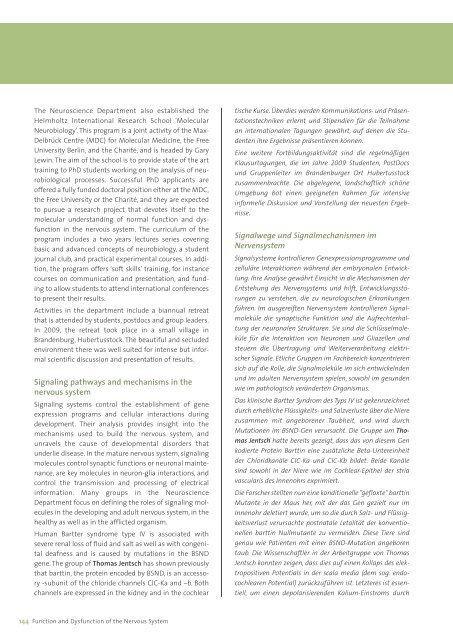Research Report 2010 - MDC
Research Report 2010 - MDC
Research Report 2010 - MDC
You also want an ePaper? Increase the reach of your titles
YUMPU automatically turns print PDFs into web optimized ePapers that Google loves.
The Neuroscience Department also established theHelmholtz International <strong>Research</strong> School ‘MolecularNeurobiology’. This program is a joint activity of the Max-Delbrück Centre (<strong>MDC</strong>) for Molecular Medicine, the FreeUniversity Berlin, and the Charité, and is headed by GaryLewin. The aim of the school is to provide state of the arttraining to PhD students working on the analysis of neurobiologicalprocesses. Successful PhD applicants areoffered a fully funded doctoral position either at the <strong>MDC</strong>,the Free University or the Charité, and they are expectedto pursue a research project that devotes itself to themolecular understanding of normal function and dysfunctionin the nervous system. The curriculum of theprogram includes a two years lectures series coveringbasic and advanced concepts of neurobiology, a studentjournal club, and practical experimental courses. In addition,the program offers ‘soft skills’ training, for instancecourses on communication and presentation, and fundingto allow students to attend international conferencesto present their results.Activities in the department include a biannual retreatthat is attended by students, postdocs and group leaders.In 2009, the retreat took place in a small village inBrandenburg, Hubertusstock. The beautiful and secludedenvironment there was well suited for intense but informalscientific discussion and presentation of results.Signaling pathways and mechanisms in thenervous systemSignaling systems control the establishment of geneexpression programs and cellular interactions duringdevelopment. Their analysis provides insight into themechanisms used to build the nervous system, andunravels the cause of developmental disorders thatunderlie disease. In the mature nervous system, signalingmolecules control synaptic functions or neuronal maintenance,are key molecules in neuron-glia interactions, andcontrol the transmission and processing of electricalinformation. Many groups in the NeuroscienceDepartment focus on defining the roles of signaling moleculesin the developing and adult nervous system, in thehealthy as well as in the afflicted organism.Human Bartter syndrome type IV is associated withsevere renal loss of fluid and salt as well as with congenitaldeafness and is caused by mutations in the BSNDgene. The group of Thomas Jentsch has shown previouslythat barttin, the protein encoded by BSND, is an accessory-subunit of the chloride channels ClC-Ka and –b. Bothchannels are expressed in the kidney and in the cochleartische Kurse. Überdies werden Kommunikations- und Präsentationstechnikenerlernt und Stipendien für die Teilnahmean internationalen Tagungen gewährt, auf denen die Studentenihre Ergebnisse präsentieren können.Eine weitere Fortbildungsaktivität sind die regelmäßigenKlausurtagungen, die im Jahre 2009 Studenten, PostDocsund Gruppenleiter im Brandenburger Ort Hubertusstockzusammenbrachte. Die abgelegene, landschaftlich schöneUmgebung bot einen geeigneten Rahmen für intensiveinformelle Diskussion und Vorstellung der neuesten Ergebnisse.Signalwege und Signalmechanismen imNervensystemSignalsysteme kontrollieren Genexpressionsprogramme undzelluläre Interaktionen während der embryonalen Entwicklung.Ihre Analyse gewährt Einsicht in die Mechanismen derEntstehung des Nervensystems und hilft, Entwicklungsstörungenzu verstehen, die zu neurologischen Erkrankungenführen. Im ausgereiften Nervensystem kontrollieren Signalmoleküledie synaptische Funktion und die Aufrechterhaltungder neuronalen Strukturen. Sie sind die Schlüsselmolekülefür die Interaktion von Neuronen und Gliazellen undsteuern die Übertragung und Weiterverarbeitung elektrischerSignale. Etliche Gruppen im Fachbereich konzentrierensich auf die Rolle, die Signalmoleküle im sich entwickelndenund im adulten Nervensystem spielen, sowohl im gesundenwie im pathologisch veränderten Organismus.Das klinische Bartter Syndrom des Typs IV ist gekennzeichnetdurch erhebliche Flüssigkeits- und Salzverluste über die Nierezusammen mit angeborener Taubheit, und wird durchMutationen im BSND-Gen verursacht. Die Gruppe um ThomasJentsch hatte bereits gezeigt, dass das von diesem Genkodierte Protein Barttin eine zusätzliche Beta-Untereinheitder Chloridkanäle CIC-Ka und CIC-Kb bildet. Beide Kanälesind sowohl in der Niere wie im Cochlear-Epithel der striavascularis des Innenohrs exprimiert.Die Forscher stellten nun eine konditionelle “gefloxte” barttinMutante in der Maus her, mit der das Gen gezielt nur imInnenohr deletiert wurde, um so die durch Salz- und Flüssigkeitsverlustverursachte postnatale Letalität der konventionellenbarttin Nullmutante zu vermeiden. Diese Tiere sindgenau wie Patienten mit einer BSND-Mutation angeborentaub. Die Wissenschaftler in der Arbeitgruppe von ThomasJentsch konnten zeigen, dass dies auf einen Kollaps des elektropositivenPotentials in der scala media (dem sog. endocochlearenPotential) zurückzuführen ist. Letzteres ist essentiell,um einen depolarisierenden Kalium-Einstroms durch144 Function and Dysfunction of the Nervous System
















